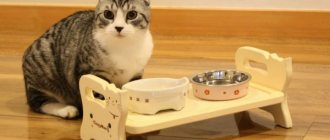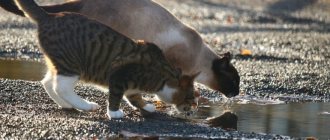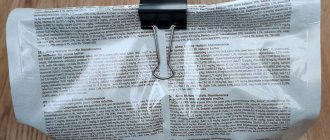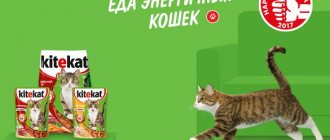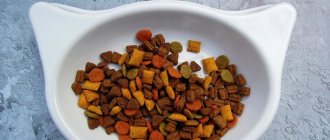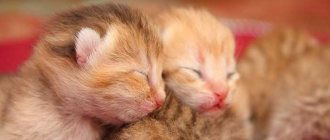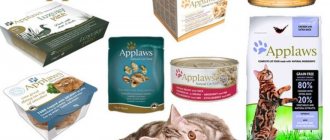When a person adopts not a kitten, but an adult pet, sometimes he is faced with the fact that the cat categorically does not eat dry food. Most often this happens because the cat got used to eating something else while living with the previous owner or on the street. Volunteers at the Murkosha shelter often encountered a similar problem and over time developed a specific strategy that helps transfer the cat to dry food.
1) The benefits of dry food 2) Why an adult cat does not eat dry food 3) Why a kitten does not eat dry food 4) Features of accustoming to dry food
The benefits of dry food
The very first and most important question: is it necessary to switch the cat to dry food at all? Need to! The fact is that the food on our table does not even closely resemble the diet of the wild ancestors of modern cats in their natural environment. In other words, such food will not be balanced for cats. Even more - certain products (very often found on our table) are extremely dangerous for a cat’s body.
Read more: Natural food for cats: benefit or harm?
Experienced volunteers, specialists from the Murkosha shelter and veterinarians almost unanimously say that you should prefer high-quality professional food. Its advantages:
— balance – the food contains a sufficient amount of fiber, vitamins and the correct ratio of proteins, carbohydrates, fats; - ease of determining the norm - the amount of food is determined by the age and weight of the cat; — no threat of poisoning if stored correctly; - a wide selection of feeds - there are therapeutic and preventive feeds intended for different breeds and ages.
Why is it important to monitor your baby's appetite?
“Beginner” owners probably have a question: why and where does so much fuss and indignation come from when it comes to some kind of appetite? Is it really so important that it be regular, full and healthy? In fact, as was mentioned just above, appetite is almost a key indicator not only of health, but also of the baby’s overall condition. For example, as soon as he is literally torn away from his mother, he experiences strong emotional experiences and may lose his appetite, which will tell us that not everything is in order with the animal’s condition.
Read also: Why do I love nature?
People often draw parallels between kittens and children. Of course, to many of us this may seem wild and even somewhat offensive, but it is in this context that it will be fair. A kitten is the same child that needs constant care, extra attention and, obviously, good food, from which it can get all the necessary nutrients (proteins, fats, carbohydrates, vitamins, etc.) in order to then normally build its own body. If the need to maintain your body normal disappears, then this is clearly a sign of something bad. It is best to start monitoring him closely at the first sign that your kitten is not eating. This will help to establish the true cause of the ailment and really understand what the baby is missing.
Why doesn't an adult cat eat dry food?
There are several main reasons for refusing dry food:
1. Habit. If a cat lives with a person, it gets used to the latter’s lifestyle and diet. Such habits are difficult to eradicate because they begin to work at the level of reflexes.
2. Wrong smell. Often, cats don't like a certain type of food simply because it doesn't smell like natural food. If, for example, a cat is accustomed to catching mice or eating meat from the owner’s table, then after sniffing the food, she will understand that it is a completely different product and will begin to refuse.
3. Consistency and temperature. These two parameters are very important for a cat. And if he doesn’t like the food to be cold or too large, the cat will refuse to eat it.
Reasons for a cat refusing to eat
Refusal to feed is not always a sign of illness. It is important not to panic and correctly analyze the situation.
Reasons for refusal:
- Weather. High temperatures are difficult to tolerate not only for people, but also for cats. Often animals become less active because it is difficult for the body to function in such conditions. Lack of movement reduces the need for food. The pet may not eat for several days. There's nothing wrong with that. The main thing is to provide access to plenty of fresh water and shade.
- Stress. Moving, losing a favorite toy, relatives coming to stay, a conflictual atmosphere in the house - all this can easily traumatize the tender soul of a fluffy. He may stop eating and become active. During this period, try to isolate him from unfavorable factors and please him with something. The veterinary pharmacy and pet store Gomeovet will help you choose interesting toys so that your cat can more easily cope with a stressful situation.
- Changing your diet. Often, owners like to change food, but do not prepare their pet for this. Each cat gets used to its own diet. If she has been fed store-bought food for a long time, she is unlikely to be able to quickly get used to eating porridge and raw meat. Remember that everything needs to be approached gradually.
- Individual characteristics of the body. Before giving birth and during heat, animals may also refuse to eat. This is absolutely normal. It seems that the body, on the contrary, should want to eat more and save energy, but no. The hunger center in the central nervous system is switched off. Exactly those parts of the brain that are important to the animal during this particular period begin to be excited. But if the cat refuses to eat for a long time, and its condition noticeably worsens, then it is better to consult a doctor.
These were, perhaps, reasons that should not cause concern to the owner. But, unfortunately, not only these 4 points make our friends refuse to eat. There are much more dangerous moments:
- Gastrointestinal diseases. Ulcers, erosions, inflammations, tumors, sore teeth, problems in the TMJ, internal bleeding - all this is not the entire list of what can cause illness in your pet. Often such problems are accompanied by a large bouquet of other symptoms, ranging from decreased activity to bloody stools.
- Parasites. Helminths and fleas can easily undermine the health of your furry. They cause vomiting, diarrhea, and loss of appetite. Therefore, it is important to periodically give your pet antiparasitic drugs after consulting a specialist.
- Poisoning. Typically, cats that live in apartments rarely encounter any problems, but it is still possible. The pet could eat something from the table, inhale household chemicals, taste watercolors or face cream. Poisoning is accompanied by diarrhea, vomiting, loss of appetite, and decreased physical activity.
- Foreign bodies. Whose cat doesn't like to eat rain from the Christmas tree? Some pets are ready to feast on thread, ear sticks, hair ties, bottle caps and small toys at any time. They can cause gastrointestinal irritation, obstruction, pain and malaise.
- Viruses. Colds. Just like in humans, an animal’s appetite disappears when it has a cold. The body is trying to force all its reserves to work for recovery; it simply has no time to digest anything. Energy supply is limited!
- Organ diseases. The animal usually feels unwell and in severe pain. The hunger center turns off. This often happens with diseases of the urinary system.
Why doesn't my kitten eat dry food?
You should start accustoming a kitten to dry food after 3 months (it is possible at 1-1.5 months, but strictly if the kitten receives milk from its mother cat). Usually, if the kitten has not yet been accustomed to home-cooked food, the process goes quite quickly and the kitten easily begins to eat dry food. But some people are picky. And it also happens that a kitten, who has already begun to get used to dry food, suddenly refuses it. This often confuses owners. But most likely the reason lies in one of the following:
1. The kitten does not have enough clean drinking water. If a kitten eats dry food, then it should consume much more water than with other types of feeding (natural food, wet food). With a dry diet, the pet must have unlimited access to drink, since a large amount of moisture is spent on softening the granules.
Read about what water should be like for your pet: Can cats drink tap water?
2. You should not mix old and new portions of food, especially if the proportion of dry food is not yet 100% and all the food is in one bowl. The food left over from the previous meal acquires an unpleasant smell for the kitten (especially if the food tends to spoil quickly, and this includes, for example, wet food), so he refuses it. To prevent this from happening, you should:
- correctly calculate the serving volume; - wash the cat's bowl after feeding; — offer other “meals,” including cat treats, in separate dishes.
3. The problem may also be due to improper storage of feed. Factory packaging that does not have special fastenings is not very suitable for storage after opening, since the food can deteriorate and the aroma is lost. And food that does not smell is no longer food for a kitten. The solution here is a special container with a tight lid for storing food, which can be bought in any household goods department.
How to help a cat?
Monitoring your cat's diet is very important. This can help avoid serious illnesses and other serious problems.
If you are sure that refusing to eat is not associated with any pathologies, then you can try on your own:
- Protect the animal from stress and ensure proper rest. Let them get used to the new environment, if necessary.
- Buy new interesting toys.
- Try to return to the old diet and begin to introduce a new one again, but gradually.
- Provide living things with plenty of water.
- Do not let the cat stay in the sun for a long time or just in a stuffy room.
Remember that in case of any ailment it is better to consult a specialist. The sooner you do this, the better. Only a doctor can correctly and quickly diagnose and prescribe treatment. Wasted time threatens to lead to irreparable consequences. The veterinarian at the clinic has high-quality equipment that can thoroughly diagnose pathologies. Visit your doctor and protect your pet from pain and complications. Caring for a pet means caring for its health.
Rules for switching to new food
When changing your usual diet, you need to be patient and consistent. You should not scold an animal or indulge it when it presses for pity. A sharp transition is harmful to health, so the new food needs to be mixed a little with the old one. On average, this takes 1-2 weeks.
Frequent product changes are harmful!
Frequently changing brands is fraught with problems with the gastrointestinal tract. To avoid diarrhea and constipation, veterinarians recommend sticking to a specific brand even on a therapeutic diet. This is not so difficult, since most manufacturers produce several lines that take into account the age and other characteristics of the animal.
Transition from straight
It's not safe to mix different types of foods, so don't be surprised by temporary bowel problems. In this case, this cannot be avoided, so be patient and adhere to the following scheme:
- 25% “drying” and 75% natural – 1-4 days;
- 50% of each type – 5-9 days;
- 75% “drying” and 25% natural – 9-14 days.
At the end of 2 weeks, pellets should make up 100% of the diet. For the first 4 days, you can soak them a little in water so that your pet is not scared off by the unusual consistency.
Switching from wet food
Feeding only wet canned food softens the gums, causing increased bleeding and premature tooth loss. For this reason, they should be combined with dry granules.
The principle of transition here is similar to the previous point. The only difference is that the final proportion must correspond to the instructions on the food packaging. There are detailed rules for feeding animals with 2 types of food.
Please note that increasing the amount of dry kibble will require a large amount of liquid to digest it. Make sure your pet drinks enough water and replace it with fresh water regularly.
Switching from one brand of granules to another
“Crusks” of different brands differ in taste, smell, shape and consistency. Because of this, animals have many reasons to ignore a new type of food.
If your pet selectively eats the granules that are familiar to him, try lubricating the new food with spider jelly. The taste and smell of meat pieces are more intense, so the cat will eat food unfamiliar to him with great pleasure.
Mix in the new food gradually and monitor the reaction. If your pet does not have health problems, do not add a new portion until he eats what is left in the bowl. Thanks to hunger, the cat will eventually come to terms with the new diet and will not be picky.
Conclusion
If your cat doesn’t want to eat dry food, don’t scold her and try to figure out the reason for her refusal. In most cases, the problem that arises is associated with errors made in care and maintenance. All of them can be fixed and are not critical, so do not rush to attribute the problem to pickiness ahead of time.
The article is for informational purposes only. Contact your veterinarian!
Do you like the article? 177
Important rules for transferring a pet to dry food from other types of food
When switching a cat to another type of food, you must follow several important rules:
- Taking into account the needs of the pet. The cat's preferences should be taken into account before offering another food. If your pet is a big fan of chicken, then it is unlikely that he will eat meat crackers. But indicating the type of meat on the package is not an advertising ploy, as many people think. A self-respecting manufacturer provides truthful information, which cannot be said about budget food. They use flavorings that are identical to natural ones. In addition, high-class industrial food is initially designed for the specific needs of the pet: to facilitate the removal of hairballs, for sterilized cats, for active cats. You should immediately take these nuances into account so that your pet receives a diet that suits its needs.
- Gradual means a gentle introduction of industrial feed into the diet. A sudden change is harmful and even destructive. It is enough to replace 1/10 of the usual portion with “crackers” and increase it daily by 1/10.
Every day you should replace only 1/10 of your pet’s usual diet with dry food.
- Time. The transfer from one type of feed to another should be carried out within 10–14 days. During this time, the cat will already taste new food. After this time, only the industrial product should be in the bowl.
- Unobstructed access to water. This is the most important rule when feeding commercial food.
The nuances of switching to dry food from different diets
Depending on what the cat ate previously, there are some nuances when switching it to dry food.
From wet industrial food
If the cat ate canned food, that is, wet industrial food, then everything is simple. In the first 2-3 days, crackers must be pre-soaked to the desired consistency. Gradually, soaking can be replaced with light moistening with the sauce from these canned foods. That is, mix the granules into a bowl, let it brew, and then offer it to the cat. At the last step, you can simply stir in either just the sauce or just the pieces. And after complete adaptation, leave only dry food.
From natural homemade food
The same rule applies here as with wet food. But cats are very suspicious animals and can easily recognize deception. Experts recommend starting with mixing canned food into natural food, and only then switching from wet industrial food to dry food. By the way, it will take the same amount of time: about two weeks.
There is another, simpler way: offer a dry food pellet as a treat. And specifically for a hungry pet. If no problems arise, then pour the food into the bowl during feeding hours.
My mother decided to switch her cat to dry food. I bought him a pack of Royal Canin. But the pet did not appreciate the taste or smell of the new food at all - he simply buried it with his paw, twitched his tail and walked away. Mom tried to soak it and mix it in, but the cat had no intention of even trying the new treat. Then they bought him a banal “Friskies”. It was he who ate him by both cheeks. But, of course, you can’t feed an animal with this product all the time. The next experiment was with Purina Van food. It fit perfectly too. And finally, the final product in this chain was Purina ProPlan food. Both the owner and the pet settled on it; it suits them in all respects. So if your cat refuses dry food, he may simply not like the taste or smell of this product. And never buy large packs of expensive food at once - there is a chance that you will have to feed it to street cats.
In case of partial replacement of other feeds with dry food
Many cats are not particularly mischievous and happily eat both wet and dry food. This is quite normal, especially if there is only one manufacturer. As a rule, problems with replacement do not arise here. The owner should only strictly decide at what hours he feeds dry food and at what hours he feeds wet food.
The food is not suitable for the cat
As we noted above, a cat's appetite is controlled by its sense of smell. A cat, like any predator, needs meat, and he determines how much of it is in a product by smell. If the food smells like grain, you shouldn’t be surprised at your pet’s poor appetite. Persuasion will not help here: cats act according to their instincts, which allowed them to survive in the harsh conditions of the wild.
Signs that the food is not suitable for your cat:
- The cat always ate this dry food reluctantly, but now he has stopped altogether;
- the diet contains little meat and a lot of grains;
- there are no animal fats in the food: they are partially or completely replaced by vegetable oils;
- the ingredients are named in groups with general words, for example “meat and its derivatives”, “offal”, “poultry meal”, which indicates the low quality of the ingredients used.
Solution
Carefully study the composition of the product you feed your pet. We wrote earlier about what good cat food should be like. If the composition turns out to be unsatisfactory, the diet will have to be changed to a higher quality one.
Is there a problem?
It also happens: the cat does not ignore the food completely, but eats only a few granules and moves away from the bowl. An inexperienced owner begins to worry, change food, rush from “drying” to “natural” and back again. In fact, there is no reason to worry: most domestic cats behave this way.
They practice the so-called buffet type of nutrition: during the day they make 10–15 approaches to the bowl, eating a little each time. Therefore, the main task of the owner is to comply with the daily allowance indicated on the food package, without overfeeding the animal and making sure that it eats normally. At the same time, it is important not to forget about drinking water: access to it should be around the clock.
See a doctor immediately!
Let’s say your cat has always eaten a particular dry food well, and then suddenly he flatly refuses it, and for the second day. This is a serious cause for concern, especially if your pet shows lethargy, depression, discharge from the eyes and/or nose, vomiting, upset stomach, or any other signs of poor health.
Loss of appetite is a symptom of a serious illness, because the body suppresses the feeling of hunger only in extreme cases, when it has absolutely no resources left to maintain digestion - all of them are spent on fighting the enemy. We strongly advise you not to delay visiting the veterinary clinic, because we are talking about the health and life of your animal, and the count can last for days, or even hours.
Bad food
When an animal does not eat dry food well, sometimes the reason lies in the quality of the product itself. Perhaps it is not tasty enough or spoiled. Cats are obligate carnivores and are most attracted to meat, so it is important to choose food with a high content of it. Acana and Orijen diets consist of 75–85% meat ingredients and other animal products (fish, eggs, innards). This is an excellent choice both for raising kittens and for maintaining the body of an adult cat.
Don't forget that even the highest quality food can be spoiled if it is expired or stored incorrectly. Cats, like other animals, have an innate ability to distinguish healthy and safe food from harmful and inedible food. If the fats in the food have oxidized, a person may not feel it, but the kitten will not eat such food, and rightly so. The owner will have to purchase fresh packaging of food and store it properly in the future.
How to train a cat to eat what they give?
The taste and smell of food is of great importance to cats. Therefore, when you switch your pet to a new type of food or a different brand of food, it is better to act gradually, rebuilding the diet over the course of a week. First, no more than 20% of the portion is replaced with new food. Then every day they increase its share, bringing it to 100%.
The cat feels the familiar aroma and is more willing to start eating. In addition, gradual changes in diet protect your pet from digestive problems during the adaptation period.
Unfortunately, this “canonical” method does not work with picky cats. Even with an almost homogeneous mass of food, they are able to discard small particles that they do not like. As a result, the granules of the new food remain in the bowl, and the animal walks around hungry and dissatisfied. Well, we'll have to resort to more drastic measures.
In fact, the kitten eats not so bad
Often, owners only think that the animal is not eating enough. In reality, the whole point is that the baby’s needs are small. Calculate the daily feeding amount for your pet and see if he eats it. For Acana and Orijen feeds, the daily dosages are as follows:
- 60 grams per 1 kg of weight when the kitten has not yet reached the age of 20 weeks;
- 30 grams per 1 kg of weight - after 20 weeks (during this period, kittens no longer grow so intensively).
Upon reaching 12 months, the cat is considered an adult and should eat in accordance with the general norm.
Refuses dry food? Let's put it on the water!
Remove any food and leave only water. After 24 hours, offer your cat dry food again. During this time, most animals work up an excellent appetite and begin to eat what is given. The most stubborn ones can starve for two days, but on the third they, as a rule, capitulate. It is considered safe for adult cats to abstain from food for 72 hours.
When you start feeding after a fast, pour the granules into a bowl and walk away. You should not watch the cat with the whole family, waiting for its reaction. Otherwise, she may again show stubbornness and refuse to feed.
Food vagaries
Little kittens evoke affection and a desire to care. Everyone around is trying to treat them with something tasty, without thinking about the consequences. In fact, such “care” backfires on both the owners and the animal:
- the baby develops the habit of begging;
- food whims arise: the kitten does not eat dry food well, because it hopes for something “yummy”;
- nutrition is not balanced, which negatively affects the development of a growing body.
During the period of accustoming to dry food, it is recommended to exclude all treats and treats. Warn all family members about this so that they do not inadvertently violate your plan.
